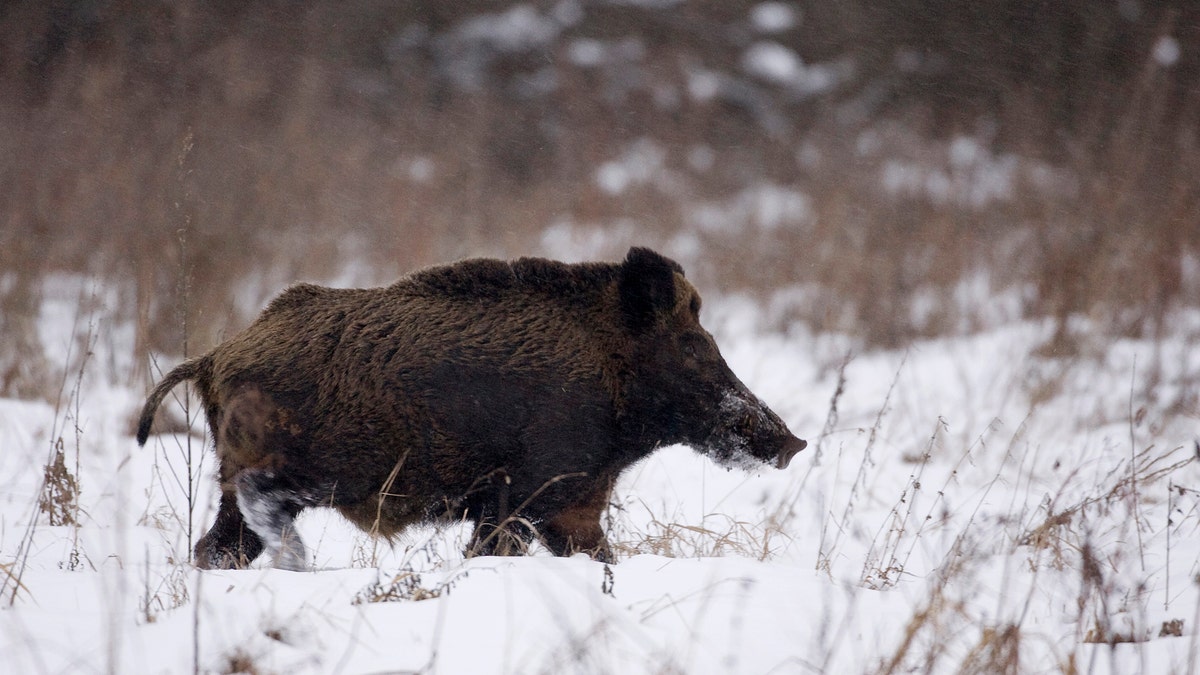
File photo - a wild boar runs in the 18 miles exclusion zone around the Chernobyl nuclear reactor near the village of Babchin, some 217 miles southeast of Minsk, January 9, 2009. (REUTERS/Vasily Fedosenko)
Some 31 years after the world’s worst nuclear accident in Chernobyl, a wild boar with more than 10-times the safe limit of radiation has been killed by hunters hundreds of miles away in Sweden.
After the 1986 catastrophe at Chernobyl in Ukraine, a cloud of radioactive particles reached parts of Sweden, leaving a frightening environmental legacy.
Environmental consultancy Calluna is seeing extremely worrying radiation levels in wild boars in Central Sweden. Local hunters are now wary of killing the boars for food.
“Hunters won’t shoot the animals,” Calluna Environmental Consultant Ulf Frykman told Fox News.
INSIDE THE NEW EFFORT TO ENTOMB CHERNOBYL'S WRECKAGE
Frykman explained that, of 30 wild boar samples taken from the area surrounding the city of Gävle this year, only six were below the safe radiation limit of 1,500 becquerel per kilogram (Bq/kg). Alarmingly, flesh from one wild boar that had been killed by hunters registered a massive 16,000 Bq/kg, while others were 13,000 and 11,000 Bq/kg.
“When you see 16,000 [Bq/kg], people get worried,” he said.
Additionally, five wild boar samples from the area around Tärnsjö, also in Central Sweden, measured above 1,500 Bq/kg.
Wild boars’ feeding habits make them particularly vulnerable to lingering contamination from the radioactive isotope cesium-137. Frykman explained that, because the boars root in the soil for food, they are more exposed to the isotope. “The cesium stays in the ground,” he said. “It’s not a problem for moose and deer any more who eat higher up, from bushes.”
AMID CHERNOBYL'S RUINS, SOMETHING OF VALUE REMAINS
Of around 400 moose that were tested last year, only one or two were over the 1,500 Bq/kg level, according to Frykman.
The environmental consultant, however, expects to see even higher radiation levels in wild boars as the animals continue to migrate north. The soil north of the Tärnsjö area has double the level of contamination, he said, adding that wild boars measuring 30,000 to 40,000 Bq/kg may be seen next year.
Frykman is concerned that, if hunters don’t shoot the wild boars, their growing population will get even bigger, causing problems for crops. “The families of wild boars are growing fast – it’s worrying,” he said.
The Telegraph reports that workers at the Forsmark nuclear plant near Gävle were the first to raise the international alarm after the Chernobyl disaster.
RADIOACTIVE BOARS RAMPAGING THROUGH GERMANY
Wild boar populations in other parts of Europe, such as Germany, have also been contaminated with radioactivity in the aftermath of Chernobyl.
Earlier this year the New York Times reported that hundreds of radioactive wild boars were roaming Fukushima in Japan, six years after the nuclear plant’s meltdown.
Follow James Rogers on Twitter @jamesjrogers
